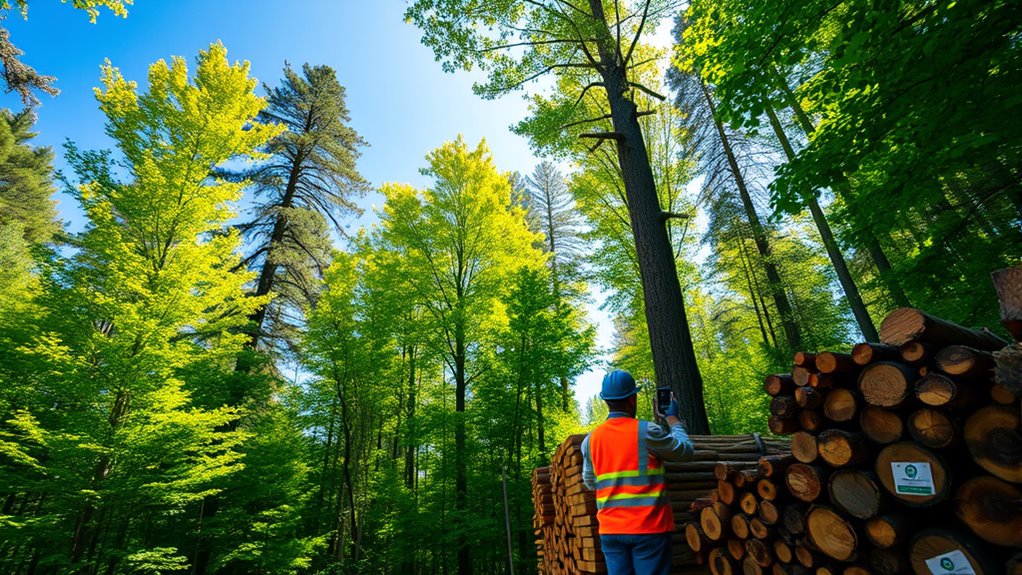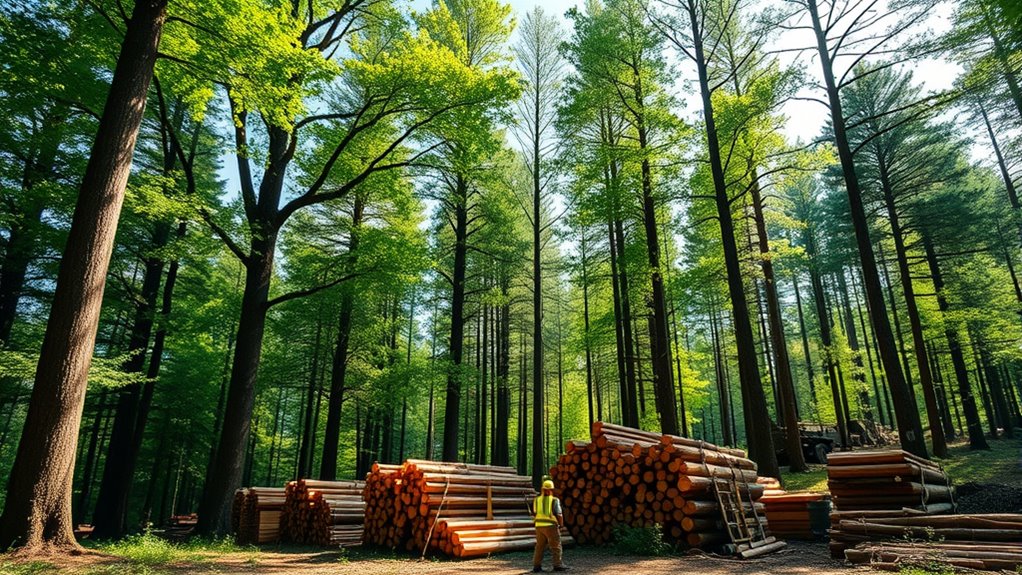Sustainable wood sourcing involves choosing certified products, like FSC or PEFC, that guarantee responsible forest management and traceability. It also means adopting eco-friendly practices such as selective logging, reforestation, and digital tracking to boost transparency and prevent illegal harvesting. Prioritizing low-risk areas, supporting social forestry, and building strong industry partnerships help protect biodiversity and promote ethical practices. If you want to discover more about responsible sourcing strategies, there’s plenty to explore ahead.
Key Takeaways
- Obtain FSC or PEFC certification to ensure wood originates from responsibly managed forests.
- Implement supply chain traceability using digital tracking and on-site audits to verify sustainable sourcing.
- Practice selective logging and reforestation to minimize environmental impact and promote forest health.
- Prioritize sourcing from low-risk regions with strong anti-illegal logging laws and effective governance.
- Engage stakeholders and communities to support social responsibility and sustainable forest management practices.
Understanding Certification and Its Role in Sustainability

Have you ever wondered how the wood products you purchase can be truly sustainable? Certification plays a crucial role in guaranteeing responsible forest management. FSC certification guarantees that products come from well-managed forests, promoting environmental, social, and economic benefits. PEFC covers over 280 million hectares, emphasizing responsible practices and economic growth. These certifications involve third-party verification, where independent experts assess forestry operations through on-site evaluations, documentation reviews, and stakeholder consultations. They also ensure compliance with strict standards like AS/NZS 4708. Certification benefits you as a consumer by supporting sustainable sourcing, enhancing market access for producers, and boosting their reputation. Overall, these global standards help maintain consistent, responsible practices in the wood industry, making sure your purchase supports healthy forests worldwide. Additionally, certification programs provide a framework for continuous improvement, encouraging forest managers to adopt better practices over time. The verification process often includes independent experts, ensuring transparency and accountability in sustainable forest management.
Implementing Sustainable Forestry Practices

To implement sustainable forestry practices, you need to focus on techniques like selective logging to minimize environmental impact. Reforestation and continuous monitoring help guarantee forests remain healthy and resilient over time. By applying these methods, you can balance resource use with ecological preservation effectively. Sustainable forestry also involves developing and following comprehensive forest management plans that prioritize biodiversity and ecosystem health. Incorporating responsible sourcing standards ensures that wood harvesting aligns with conservation goals and supports local communities. Additionally, adopting cybersecurity measures can protect digital data related to forest management from cyber threats. Understanding the importance of forest health monitoring allows for proactive responses to potential ecological disturbances. Recognizing the role of myelination in neural development underscores the importance of healthy environments for cognitive growth. Moreover, understanding regulation compliance is crucial to ensure that forestry activities adhere to legal standards and avoid penalties.
Selective Logging Techniques
How can forestry operations balance timber extraction with environmental preservation? Selective logging techniques offer a solution by harvesting specific trees instead of clear-cutting, preserving biodiversity and ecosystem health. Methods like single-tree and group selective logging allow you to remove high-value or target groups of trees while maintaining forest structure, reducing soil erosion, and protecting water quality. Using reduced-impact techniques, such as directional felling and narrow trails, minimizes disturbance. Although these methods are more labor-intensive and costly, they support long-term forest regeneration and ecological stability. Implementing sustainable forest management principles ensures that economic benefits are balanced with environmental health, fostering responsible resource use. Incorporating selective logging practices can also enhance the resilience of forests to pests and climate change. Additionally, adopting sustainable harvesting methods can improve forest productivity and carbon sequestration. By implementing selective logging, you can maximize economic benefits while safeguarding the environment for future generations. Emphasizing integrated forest management approaches helps to coordinate conservation and utilization efforts effectively.
Reforestation and Monitoring
Implementing sustainable forestry practices begins with effective reforestation and ongoing monitoring efforts. You need to select suitable methods like clear-cutting, seed tree, or natural regeneration, depending on local conditions and species. Manual planting can enhance biodiversity and create jobs, while monitoring guarantees forest health, soil quality, and biodiversity remain balanced. Regular assessments of tree survival rates and soil conditions help identify areas needing improvement. Using innovative tools like drones for planting, remote sensing, and GIS can make reforestation more efficient and precise. Community involvement boosts local support and sustainability. Monitoring technologies enable early detection of issues, ensuring timely interventions. By continuously evaluating ecological and economic impacts, you ensure reforestation efforts contribute to resilient ecosystems, carbon sequestration, and community benefits, supporting long-term sustainable wood sourcing.
Ensuring Supply Chain Transparency and Traceability

To guarantee supply chain transparency, you need to accurately track wood origins and verify certifications. Using digital tools and scientific methods can help confirm that products come from responsible sources. Maintaining supply chain integrity requires diligent supplier vetting and regular monitoring to prevent risks and meet regulations. Implementing traceability systems can further enhance transparency by providing detailed records of each step in the supply chain. Additionally, understanding how cookies are used on related platforms can help ensure data privacy and compliance with applicable regulations. Employing asset division strategies during supply chain management can help allocate responsibilities and mitigate potential disputes. Incorporating preppy dog names into branding strategies can also appeal to consumers seeking sophisticated and stylish associations with sustainable products. Furthermore, integrating blockchain technology can improve the security and verifiability of supply chain data, fostering greater consumer trust.
Tracking Wood Origins
Tracking wood origins is essential for ensuring supply chain transparency and verifying the legality and sustainability of forest products. To do this effectively, you can combine methods like genetic analysis, wood anatomy, and chemical profiling. Genetic methods such as DNA barcoding and population genetics help identify species and trace geographical origins, though they require extensive reference databases. Traditional wood anatomy remains useful for species identification, especially with non-destructive techniques. Chemical methods, including mass spectrometry and near-infrared spectroscopy, offer detailed signatures but need specialized equipment. Digital tracking systems like RFID transponders and QR codes provide real-time monitoring and data integration. Genetic testing has been instrumental in verifying the origin of timber and preventing illegal logging, further supporting supply chain transparency. Implementing robust traceability systems is crucial for maintaining accurate records and ensuring accountability across the supply chain. Additionally, adopting standardized protocols can improve consistency and reliability in wood origin verification. Here’s a visual overview:
| Method Type | Key Feature | Limitation |
|---|---|---|
| Genetic Methods | Accurate species and origin tracing | Requires reference databases |
| Wood Anatomy | Widely established, non-destructive | Challenging with similar species |
| Chemical Methods | Detailed chemical signatures | Equipment needed |
| Digital Systems | Real-time tracking and monitoring | Technology costs |
| Data Collection | Essential for reliable traceability | Building comprehensive databases |
Certification Verification Methods
Certification verification methods play a crucial role in maintaining transparency and traceability within the wood supply chain. You’ll rely on on-site evaluations, where physical inspections verify compliance with standards like FSC and SFI. Documentation review is essential; you’ll examine detailed records of sourcing practices to confirm legitimacy. Supply chain mapping helps identify risks and ensures clear traceability from forest to product. Auditor training ensures assessments are thorough and consistent. After audits, certification reports provide transparent documentation of findings. Maintaining the chain of custody keeps the identity of certified wood intact throughout the supply chain. Public disclosure of audit results and digital tracking tools further enhance transparency. FSC’s certification process ensures that products meet rigorous environmental and social standards, providing confidence to buyers and consumers. By applying these methods, you can confidently verify that wood sourcing aligns with sustainability standards and legal requirements. Incorporating traceability systems can further strengthen the integrity of the supply chain and protect against mislabeling or fraud. Additionally, integrating supply chain transparency practices can help identify potential issues early and promote responsible sourcing throughout the industry. Implementing comprehensive verification procedures ensures ongoing compliance and accountability within the supply chain. Furthermore, utilizing innovative digital tracking tools can improve real-time monitoring and increase overall supply chain efficiency.
Ensuring Supply Chain Integrity
Ensuring supply chain integrity requires a proactive approach to transparency and traceability, which are essential for verifying sustainable sourcing practices. You should request documentation from suppliers, like certifications and proof of sustainable practices, and conduct on-site visits to observe operations directly. Asking about wood sourcing origins and supplier sustainability credentials helps verify upstream practices. Performing background checks and maintaining ongoing communication guarantees consistency over time. Regular monitoring and third-party audits help detect lapses and enforce corrective actions. Using technology-based tracking tools enhances transparency and identifies disruptions. Implementing chain of custody certification systems and adopting standards like ASTM D7612-21 enable you to track wood from forest to final product. Incorporating traceability systems further ensures the accuracy and reliability of the sourcing information. Additionally, leveraging vibrational alignment techniques can support the development of a transparent and trustworthy supply chain culture, reinforcing stakeholder confidence. Incorporating supply chain transparency can also help identify potential sustainability issues early in the process. Emphasizing lifecycle assessment can provide comprehensive insights into the environmental impacts at every stage of the supply chain, promoting more sustainable decisions. Sharing traceability data fosters trust and accountability among stakeholders, strengthening overall supply chain integrity.
Embracing Reuse, Recycling, and Circular Economy Principles

Embracing reuse, recycling, and circular economy principles is essential for sustainable wood sourcing because it maximizes resource efficiency and minimizes waste. Reusing wood, such as salvaged materials from buildings and bridges, supports local markets and reduces transportation emissions. It retains existing carbon sequestration in trees and adds character to modern décor, furniture, and flooring. Recycling wood scraps into composite products like particleboard reduces waste and decreases the demand for virgin timber, protecting forests. It also creates economic opportunities and jobs in recycling industries. Circular economy principles promote efficient resource use through closed-loop systems, designed to be perpetually cycled back into production. This approach enhances resilience, encourages collaboration, and aligns with policies aimed at waste reduction, ultimately supporting long-term sustainability in wood sourcing.
Adopting Responsible Sourcing and Ethical Business Practices

Building on the principles of reuse and recycling, adopting responsible sourcing and ethical business practices strengthens the foundation of sustainable wood procurement. You should prioritize certification standards like FSC and PEFC, which verify that wood comes from responsibly managed forests. The Carbon Smart Wood™ Program helps reduce your carbon footprint by promoting sustainable practices. Confirm suppliers provide documentation of their harvesting methods and undergo regular audits to maintain compliance. Embrace transparent supply chains by vetting suppliers thoroughly and involving industry networks for recommendations. Engage stakeholders, including local communities, to align business practices with ethical standards. Maintaining high standards of transparency, accountability, and community involvement ensures your sourcing supports ecological health, respects human rights, and promotes long-term sustainability. Responsible forest management is essential to maintaining ecological balance and ensuring the longevity of forest resources.
Navigating Geographic and Jurisdictional Factors

Understanding geographic and jurisdictional factors is essential for responsible wood sourcing, as it helps you minimize risks related to illegal logging, deforestation, and non-compliance. You should prioritize low-risk areas with strong anti-illegal logging laws and use tools like Preferred by Nature or Forest Trends for real-time assessments. Avoid high-risk regions lacking transparency, and map supply chains to identify ecosystems or endangered habitats.
| Focus Area | Key Action |
|---|---|
| Certification | Require FSC/PEFC and verify chain-of-custody |
| Climate Alignment | Target carbon-negative regions and locally sourced wood |
| Community Engagement | Source from Indigenous forests and support social forestry |
Building Partnerships and Leveraging Industry Resources

Building partnerships and leveraging industry resources are essential strategies for advancing responsible wood sourcing. Collaborating with companies like Ahlstrom-Munksjö, Metsä Fibre, and 3M helps align sustainability goals and creates shared value. These partnerships often go beyond business, supporting forest conservation, biodiversity, and local communities. You can also benefit from joint research, which improves forestry practices with input from non-profits. Additionally, partnerships increase supply chain transparency, ensuring responsible sourcing from forest to product. To maximize impact, consider these approaches:
- Engage in industry forums and networks for insights and trusted supplier recommendations
- Use certifications like FSC, SFI, and PEFC to ensure sustainable practices and appeal to eco-conscious consumers
- Support local suppliers for transparency, reduced carbon footprint, and community development
- Forests are vital for biodiversity, air purification, and carbon sequestration, yet face rising threats. Building these relationships strengthens your sustainability efforts and industry influence.
Frequently Asked Questions
How Can Consumers Verify the Sustainability of Wood Products Effectively?
To verify the sustainability of wood products, you should look for credible certifications like FSC or PEFC, which guarantee responsible sourcing. Check the product labels for these marks, and use online databases to confirm their authenticity. Also, pay attention to the chain of custody documentation, which traces the wood from forest to product. This way, you can confidently choose products that meet high environmental and social standards.
What Are the Main Challenges in Implementing Sustainable Forestry Practices Globally?
You face many challenges when trying to implement sustainable forestry practices worldwide. Climate change causes extreme weather and ecosystem shifts, making forests less resilient. Socioeconomic pressures push communities to overharvest resources for survival. Weak governance and fragmented policies hinder enforcement, while market demands and limited resources block adoption of sustainable methods. These combined factors make it tough to balance conservation with economic needs, slowing progress toward truly sustainable forestry globally.
How Do Supply Chain Traceability Solutions Address Illegal Logging Concerns?
Imagine a detective piecing together clues to catch a thief—that’s how supply chain traceability tackles illegal logging. You use tagging systems, blockchain, and satellite monitoring to verify timber origins, making fraud harder. Mobile apps and AI flag discrepancies, while third-party audits act as your witnesses. This transparency helps you guarantee products are legally sourced, reducing illegal logging and protecting forests for future generations.
What Role Do Local Communities Play in Sustainable Wood Sourcing?
You play a crucial role in sustainable wood sourcing by engaging in community activities that promote responsible forestry. Your participation helps raise awareness, support certification efforts, and advocate for policies that protect forests. By overseeing practices and ensuring transparency, you help maintain forest health, create local jobs, and preserve cultural traditions. Your involvement not only boosts economic growth but also fosters environmental conservation and strengthens social cohesion within your community.
How Can Businesses Assess the Environmental Impact of Their Wood Products?
Imagine your business as a navigator steering through a sea of choices. To assess your wood products’ environmental impact, you harness tools like Life Cycle Assessments (LCAs) and Environmental Product Declarations (EPDs). These act as your compass, revealing resource use, emissions, and sustainability. By relying on verified data and standards like ISO, you make informed decisions, ensuring your products sail smoothly towards a greener future.
Conclusion
So, after all this talk about sustainability, it’s funny how easy it is to forget that sourcing responsibly isn’t just about certifications or fancy labels. In the end, you might find that the real challenge is resisting the temptation to take shortcuts. Because nothing says “green” like a perfectly recycled, transparent supply chain—except maybe realizing that you’re still just one bad decision away from undoing all your good work. Sustainability, after all, isn’t a one-time achievement.











